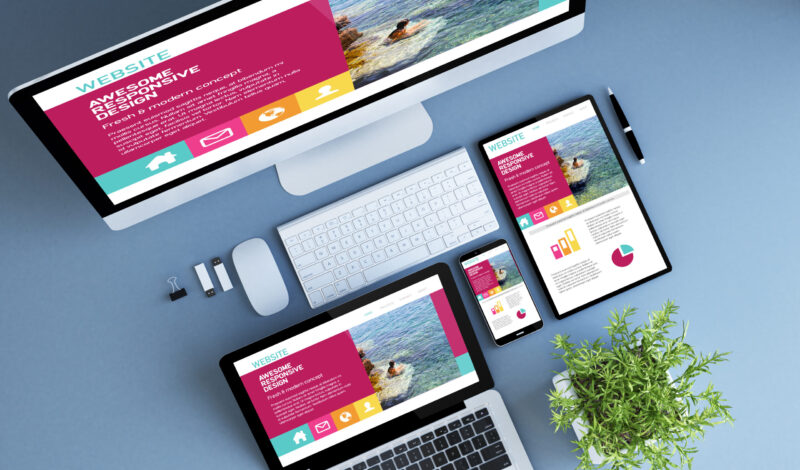Landing pages are a crucial component of any online advertising campaign. They serve as the first point of contact between potential customers and your business. Landing page optimization is the process of improving the elements of a landing page to increase its conversion rate.
A well-optimized landing page can drive traffic, increase leads, and ultimately result in higher sales. It is vital to understand your target audience, their interests, and pain points, to create a persuasive landing page that speaks directly to them.
There are several strategies for optimizing landing pages, including thorough A/B testing, simplifying the message, improving the navigation, using persuasive headlines, and clear calls to action. With the right combination of elements, your landing page can become your most effective tool for generating leads and conversions.
The Importance of Landing Page Optimization
As an expert in digital marketing, I cannot overstate the importance of landing page optimization. The landing page is the gateway to your website; it’s the first interaction that a visitor has with your brand. That’s why optimizing it for the best user experience is essential.
There are several reasons why businesses need to be concerned with landing page optimization, including:
- Higher Conversion Rates: A well-optimized landing page can significantly increase your conversion rates. By focusing on the user experience and providing clear and concise information, you can give visitors a reason to stay on your website and take the desired action.
- Improved User Experience: A seamless user experience is crucial for any website, and landing pages are no exception. By optimizing your landing page, you can ensure that visitors can navigate your website and find what they’re looking for with ease.
- Better Return on Ad Spend (ROAS): If you’re running advertising campaigns for your business, you want to make sure that you’re getting the best return on your investment. By optimizing your landing pages, you can increase the relevancy and quality of your ads, improving the ROAS.
- Increased Brand Awareness: A well-designed landing page can help establish trust and credibility with your visitors. By showcasing your brand’s unique value proposition and offering valuable information and resources, you can create a positive brand impression.
In conclusion, optimizing your landing page is non-negotiable for businesses that want to succeed in the digital landscape. By providing a seamless user experience, improving conversion rates, and increasing the return on your ad spend, optimizing your landing page can take your business to the next level.
Understanding Your Target Audience
When it comes to landing page optimization, understanding your target audience is crucial. You need to have a deep understanding of your audience’s needs, wants, pain points, and motivations in order to create an effective landing page. Here are some tips on how to understand your target audience:
- Define Your Ideal Customer: Start by defining your ideal customer. Who are they? What are their demographics, interests, and behaviors? Create a customer persona to help you visualize your ideal customer and keep them in mind when creating your landing page.
- Conduct Market Research: Conduct market research to learn more about your target audience. Use tools like surveys, social media analytics, and user feedback to gather information that will help you create a better landing page.
- Analyze Your Competitors: Analyze your competitors’ landing pages to see what’s working and what’s not. Look for common themes and tactics that they are using to attract customers. This will give you ideas for your own landing page.
- Use Data to Your Advantage: Use data to your advantage when creating your landing page. Analyze your website analytics to see where your traffic is coming from and what pages they are viewing. Use this information to optimize your landing page for specific keywords and to make it more user-friendly.
- Personalize Your Landing Page: Personalize your landing page to create a more engaging experience for your target audience. Use personalized messaging, visuals, and offers to make your landing page more appealing to your ideal customer.
By understanding your target audience, you can create a landing page that resonates with them and drives conversions. Don’t be afraid to dig deep and learn as much as you can about your audience. It will pay off in the long run.
Creating a Clear and Concise Message
When it comes to optimizing a landing page, one of the most important factors for success is creating a clear and concise message. A landing page with a confusing message is unlikely to convert visitors into customers, no matter how great the product or service may be. Here are some tips on how to create a clear and concise message:
1. Identify the Main Point
The first step in creating a clear message is to identify the main point you want to convey. This should be a single, concise sentence that summarizes what your product or service is all about. It should be easy to understand and communicate the value of your offer.
2. Use Simple Language
Complicated words and technical jargon can be off-putting to visitors and make it difficult for them to understand your message. Using simple language can help to make your message clear and easy to understand.
3. Highlight the Benefits
Visitors want to know how your product or service will benefit them. Make sure to highlight the benefits of your offer in a clear and concise manner. Use bullet points to make it easy for visitors to skim and identify the key benefits.
4. Keep it Above the Fold
The most important message on your landing page should be above the fold – that is, visible without having to scroll down. This ensures that it is the first thing visitors see and can help to quickly communicate your message to them.
5. Test and Refine
Creating a clear message is not a one-time effort. You should continually test and refine your message to optimize it for conversions. This could include A/B testing different versions of your message or soliciting feedback from visitors to identify areas for improvement.
By following these tips, you can create a landing page with a clear and concise message that resonates with visitors and drives conversions.
Designing for Conversion
When it comes to designing for conversion, there are several elements to consider. From the colors of your CTA button to the placement of your form, every minor detail can have a significant impact on your conversion rates. In this section, I’ll break down some essential tips to maximize your landing page’s potential.
- Simplicity is key: Focus on delivering a clean and simple layout that directs users towards the right path. Placing cluttered or complex design can hurt your conversions by complicating the user experience. Thus, it’s crucial to keep your CTA the focal point of your page and keep other elements to a minimum.
- A/B testing: Testing two versions of the same landing page can offer invaluable insights into what works and what doesn’t. A/B testing can help you identify critical issues like slow loading time, disproportionate text layout, outdated images, and much more.
- Clear Call-to-Actions: Your landing page’s CTA is the final gateway to your conversion objective. Therefore, make sure it is clear, concise, and stands out from the rest of the page’s elements. Consider using contrasting colors and placing it above the fold of your landing page.
- Trust Signals: Trust signals are elements that help build credibility and trust with users. Include user reviews, awards, or any certifications that your company might have earned. These details help build trust and confidence in your users, making them more likely to convert.
By following these tips, you can create landing pages that are visually appealing and drive higher conversion rates. Remember, designing for conversion is all about creating a simple, direct, and cohesive experience for your users.
Simplifying the form
When it comes to optimizing landing pages, one of the most important factors to consider is the form. After all, it’s the part of the page where visitors submit their information – and where most visitors tend to drop off. One way to reduce this drop-off rate is by simplifying the form.
Here are a few tips to get started:
- Reduce the number of form fields.
The more form fields you have, the longer it takes for visitors to fill out the form – and the more likely they are to abandon it. Try to limit your form to the most essential fields, such as name and email. If you absolutely need more information, consider splitting the form into multiple steps.
- Use clear and concise labels.
Make sure it’s clear what each field is asking for. For example, instead of “Company Name”, use “What is the name of your company?”.
- Provide helpful guidance.
If there are specific requirements for a field (such as a certain format for a phone number), provide clear instructions. It can also help to include examples.
- Optimize for mobile.
With mobile traffic accounting for a significant portion of website visits, it’s crucial that your forms are mobile-friendly. Make sure they’re easy to read and navigate on smaller screens.
In fact, according to a study by HubSpot, reducing the number of form fields from four to three led to a 50% increase in conversions.
By simplifying your form, you can create a more user-friendly experience for your visitors – and increase your chances of capturing their information.
A/B Testing for Optimization
As a marketer, I understand the importance of having a high-converting landing page. After all, the landing page is usually the first impression a potential customer has of our company. That’s why A/B testing is such a valuable tool in optimizing landing pages for better results.
In a nutshell, A/B testing (also called split testing) is the process of creating two or more versions of a landing page and testing them to see which one performs better. By doing this, we can identify the best design, layout, copy, and imagery to use for our landing pages.
Some benefits of A/B testing include:
- Improved conversion rates
- Greater understanding of what resonates with our audience
- Better user experience for website visitors
To get started with A/B testing, here are some steps to follow:
- Identify what you want to test. This could be the headline, images, call-to-action (CTA) button, or any other element that could impact conversions.
- Create alternate versions of the landing page(s) you want to test. Make sure you change only one element at a time so you can isolate the impact of that change.
- Use a tool to split incoming traffic between the original landing page and alternate versions. This ensures that visitors see only one version each time they visit your site. Tools like Google Optimize, VWO, and Optimizely make it easy to conduct A/B tests.
- Collect and analyze data. Use the tool to track how visitors engage with each version of the landing page. Look for patterns in behavior that indicate which version is performing better.
- Implement the winning version. Once you’ve determined which version of the landing page is outperforming the others, make that the new default version.
Keep in mind that A/B testing is an ongoing process. Just because you’ve found a winning version doesn’t mean you should stop testing. Continuously testing and optimizing your landing pages can lead to significant gains in conversion rates and overall marketing success.
Optimizing for Mobile Devices
With more and more people using mobile devices to browse the web, optimizing your landing pages for mobile is crucial. Here are a few tips to ensure your landing pages are optimized for mobile devices:
- Keep it simple: Mobile users often have shorter attention spans and less patience, so it’s important to keep your landing pages simple and straightforward. Focus on your key message and keep your design and content minimal.
- Make it fast: Mobile users expect pages to load quickly, so it’s important to ensure your landing pages are optimized for speed. Compress your images, minimize your code, and utilize browser caching to keep your page load times to a minimum.
- Ensure responsiveness: With different mobile devices having varying screen sizes and resolutions, it’s important to ensure your landing page design is responsive, meaning it can adapt to any device size or orientation.
- Focus on touch-friendly design: Since mobile users navigate with their fingers, focus on touch-friendly design elements. Use large buttons and fonts, incorporate swipeable images, and ensure your forms are easy to fill out on mobile devices.
- Optimize for local search: Many mobile searches include location-based keywords, so make sure your landing pages are optimized for local search. Incorporate local keywords into your headline and content, and include your address and contact information on your page.
According to a report by Google, 61% of users are unlikely to return to a mobile site they had trouble accessing, and 40% will visit a competitor’s site instead. By optimizing your landing pages for mobile devices, you can ensure your page loads quickly, is easy to navigate, and provides a great user experience, ultimately leading to higher conversion rates.
Reducing Page Load Times
One of the most significant factors in creating an effective and efficient landing page is reducing page load times. Slow page load times can significantly impact the user experience and lead to a higher bounce rate, which could ultimately mean lost potential customers.
Here are some ways to reduce page load times:
- Optimize images: Large images can significantly impact page load times. By compressing and optimizing images, you can reduce the time it takes for them to load on your landing page without sacrificing quality.
- Use a Content Delivery Network (CDN): A CDN is a distributed network of servers that can cache and deliver content from a server close to the user requesting it. This can help reduce page load times as the user is requesting content from a server closer to their location.
- Minimize HTTP requests: Each element on your landing page requires an HTTP request. By reducing the number of elements on your page or combining them into a single file, you can reduce the number of HTTP requests and ultimately reduce page load times.
- Enable browser caching: When a user visits your landing page, their browser caches some of the content, so it doesn’t have to be loaded again on subsequent visits. By enabling browser caching, you can reduce page load times for returning visitors.
- Minify your code: Minifying your code involves removing unnecessary characters from your HTML, CSS, and JavaScript files. This can help reduce the file size, resulting in faster page load times.
By implementing these techniques, you can significantly reduce page load times, which can lead to a better user experience and ultimately a higher conversion rate. However, it’s essential to monitor page load times regularly and make adjustments as necessary to ensure optimal performance.
Measuring and analyzing results is one of the most important steps in landing page optimization. It allows you to understand what is working well and what needs improvement. Here are some ways to measure and analyze your landing page results:
- Conversion Rates: Conversion rate is the most important metric to track when it comes to landing pages. It is the percentage of visitors who take the desired action on your landing page, such as filling out a form or making a purchase. You can use tools like Google Analytics to track your conversion rates.
- A/B Testing: A/B Testing is a testing method where you create two versions of the same landing page and test them against each other to see which one performs better. This allows you to make data-driven decisions about what changes you should make to your landing page to improve its effectiveness.
- Heatmaps: Heatmaps are visual representations of user behavior on your landing page. They can show you where users are clicking, where they are scrolling, and where they are spending the most time. Tools like Crazy Egg or Hotjar can help you create heatmaps.
- User Feedback: User feedback is another important way to measure and analyze your landing page results. You can use tools like surveys or feedback forms to collect feedback from your users. This can help you understand what users find confusing or frustrating about your landing page, and what changes you need to make to improve their experience.
- Bounce Rates: Bounce rate is the percentage of visitors who leave your landing page without taking any action. A high bounce rate can indicate that your landing page is not meeting users’ expectations, or that there is something on the page that is confusing or frustrating visitors.
By measuring and analyzing your landing page results, you can make data-driven decisions and improve the effectiveness of your landing page. Remember, it’s important to test different elements of your landing page, gather feedback from your users, and make changes accordingly.
Conclusion: The Continuous Process of Landing Page Optimization
After implementing various strategies to optimize your landing page, it’s essential to track its performance and make necessary changes continuously. Below are some key takeaways to keep in mind as you maintain and improve your landing page:
- Analytics tools such as Google Analytics can help you track key performance metrics such as bounce rate, conversion rate, and average session duration.
- Conduct a regular A/B testing of various elements on your landing page such as headlines, images, and call-to-action buttons to determine the most effective combination.
- Monitor relevant user feedback and reviews to identify areas for improvement and address any potential pain points.
- Keep your landing page up-to-date with current trends and industry best practices such as responsive design, clear value proposition, and social proof.
- Continuously analyze your target audience and adjust your landing page accordingly to provide a highly relevant and personalized experience.
Remember that landing page optimization is not a one-time task, but rather a continuous process. Regularly update and test your page to ensure that it remains effective and engaging for your audience. By dedicating time and effort towards optimizing your landing page, you can significantly increase your conversion rates and drive greater success for your business.




